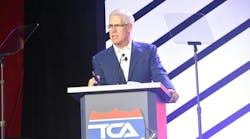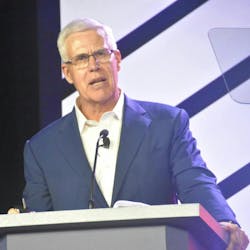NASHVILLE, Tennessee—The good news for trucking fleets is that the bad news could’ve been worse.
The “drama” surrounding the U.S. Labor Department’s recent independent contractor rule is “not as significant” nor as “cut-and-dry” as the far-reaching California worker classification law, known as AB5, according to a transportation attorney who explained the rule at Truckload 2024, the Truckload Carriers Association’s annual conference here.
But fleets and owner-operators must stay informed as legal challenges to the rule, under the Fair Labor Standards Act, work their way through the courts. Additionally, in an effort backed by the American Trucking Associations to block the rule, Rep. Kevin Kiley (R-California) and Sen. Bill Cassidy (R-Louisiana) earlier this month introduced a joint resolution of disapproval.
The heart of the rule is a six-factor test that assesses areas such as the worker's opportunity for profit or loss; investments by the worker; degree of control over the work; the worker's skill or initiative; and, most problematic for fleets, whether the worker is in the same trade or profession as the putative employer.
“Again, because it's a multifactor balancing test, if you don't pass that particular factor you still have a fighting chance to prove that your workers are independent contractors,” Scopelitis President and Managing Partner Greg Feary said. “So as we look at this and we say, ‘is it bad?’ the answer is ‘yes.’ But it's certainly not as bad as the proposed rule, which was rolled out in 2022.”
In addition to multiple legal challenges already filed in various jurisdictions, Feary also suggested that the Labor Department likely won’t aggressively ramp up auditing efforts in an election year. Because the rule falls under the FLSA, it’s focused on minimum wage and overtime issues. Interstate trucking is exempt from the latter, and most motor carriers are likely already paying above the $7.25 per hour federal minimum wage, “no matter” how various pay deductions are calculated.
“My point is, even though the Department of Labor has 10,000 enforcement officers, do you expend resources on an industry that the juice isn't really worth the squeeze? So we'll see,” Feary said. “I think the smaller-vehicle courier industry, with a little different dynamic, is probably a little bit more worried.”
See also: Contractor or employee? Labor Department posts new rule
'Knock-on effect'
Feary emphasized, however, that he is not saying the new rule is “no big deal,” because it still opens the door to class-action lawsuits from plaintiffs’ attorneys who got a “big gift” with the rulemaking’s voluminous supporting theories and citations.
“The knock-on effect is significant. Our firm alone has over 100 that we're defending, and there's hundreds against the trucking industry.” Feary said. “Guess what? There's 339 pages in this final rule… full of citations, full of arguments, made by hundreds and hundreds of government attorneys, trying to put their thumb on the scale and arguing that workers are employees, not independent contractors.”
But the rule could’ve been worse, he noted.
“There's a silver lining,” he said. “The final rule did pay attention to over 55,000 comments that were submitted to the U.S. Department of Labor. And we saw those comments, to some degree, move the needle, make some changes.”
Notably, the final rule abandons “the Scanlon principle,” which, put simply, says that workers in a highly regulated industry like trucking are probably employees.
“If they didn't abandon the Scanlon principle, we would have some problems,” Feary said. “Because that principle says all of the regulations associated with the industry really are the source of control. And we're going to attribute that source of control to the trucking companies.”
Feary also pointed to a recent promotional video posted by ATA, which he characterized as “directly accurate” in capturing the issues surrounding the IC rule.





